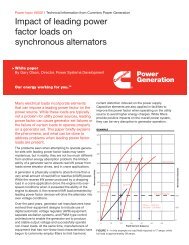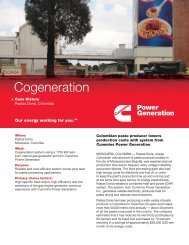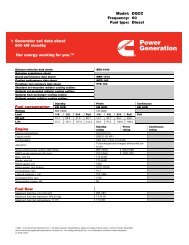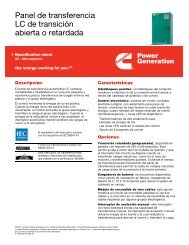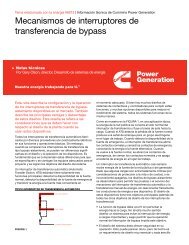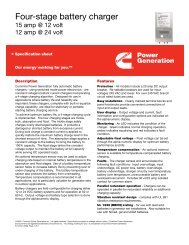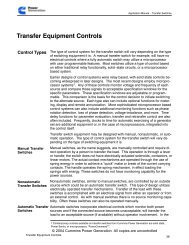appendix
appendix
appendix
Create successful ePaper yourself
Turn your PDF publications into a flip-book with our unique Google optimized e-Paper software.
Application Manual – Liquid Cooled Generator Sets<br />
Nonlinear Load<br />
A nonlinear load is a load for which the relationship between voltage and current is not a<br />
linear function. Some common nonlinear loads are fluorescent lighting, SCR motor<br />
starters, and UPS systems. Nonlinear loads cause abnormal conductor heating and<br />
voltage distortion.<br />
Octave Band<br />
In sound pressure measurements (using an octave band analyzer), octave bands are the<br />
eight divisions of the measured sound frequency spectrum, where the highest frequency<br />
of each band is twice that of its lowest frequency. The octave bands are specified by<br />
their center frequencies, typically: 63, 125, 250, 500, 1,000, 2,000, 4,000 and 8,000 Hz<br />
(cycles per second).<br />
Ohm<br />
The ohm is a unit of electrical resistance. One volt will cause a current of one ampere to<br />
flow through a resistance of one ohm.<br />
One–Line Diagram<br />
A one–line diagram is a schematic diagram of a three–phase power distribution system<br />
which uses one line to show all three phases. It is understood when using this easy to<br />
read drawing that one line represents three.<br />
Out–Of–Phase<br />
Out–of–phase refers to alternating currents or voltages of the same frequency which are<br />
not passing through their zero points at the same time.<br />
Overload Rating<br />
The overload rating of a device is the load in excess of the nominal rating the device can<br />
carry for a specified length of time without being damaged.<br />
Overshoot<br />
Overshoot refers to the amount by which voltage or frequency exceeds the nominal value<br />
as the voltage regulator or governor responds to changes in load.<br />
Parallel Operation<br />
Parallel operation is the operation of two or more AC power sources whose output leads<br />
are connected to a common load.<br />
Peak Load<br />
Peak load is the highest point in the kilowatt demand curve of a facility. This is used as<br />
the basis for the utility company’s demand charge.<br />
Peak Shaving<br />
Peak shaving is the process by which loads in a facility are reduced for a short time to<br />
limit maximum electrical demand in a facility and to avoid a portion of the demand<br />
charges from the local utility.<br />
Phase<br />
Phase refers to the windings of an AC generator. In a three–phase generator there are<br />
three windings, typically designated as A–B–C, R–S–T or U–V–W. The phases are 120<br />
degrees out of phase with each other . That is, the instants at which the three phase<br />
voltages pass through zero or reach their maximums are 120 degrees apart, where one<br />
complete cycle is considered 360 degrees. A single–phase generator has only one<br />
winding.<br />
PMG (Permanent Magnet Generator)<br />
A permanent magnet generator is a generator whose field is a permanent magnet as<br />
opposed to an electro–magnet (wound field). Used to generate excitation power for<br />
separately excited alternators.<br />
G–8 APPENDIX G<br />
Rev. Jan 2011





